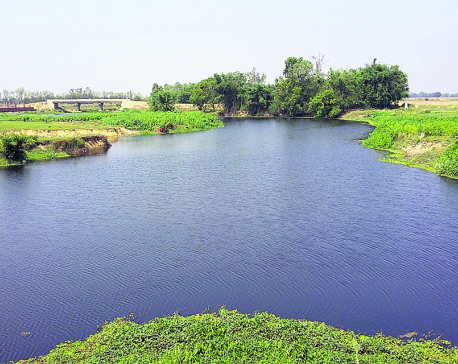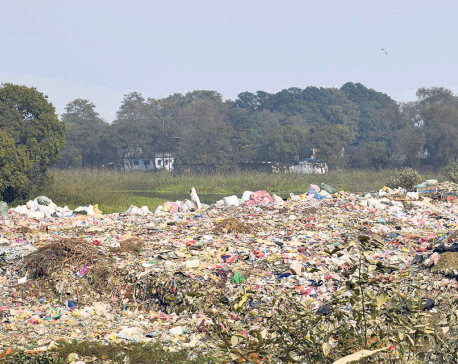
OR
Citizen science project aims for urban resiliency along Danda River
Published On: February 10, 2019 02:03 AM NPT By: Ram Saran Tamang
KATHMANDU, Feb 9: Every year during spring, flocks of migratory birds come to Nepal seeking suitable breeding grounds and summer habitats. Danda River of Rupandehi, which harbors numerous fishes, reptiles, and insects, offers these birds plentiful prey and a safe haven for their stay.
But the increasing pollution has been threatening the river's biodiversity and its sensitive riparian ecosystem.
This 22-kilometer groundwater-fed river system, which also carries great irrigation and religious significance, starts from the north-east corners of Rupandehi and Nawalparasi districts. It runs southwest, flowing through farmlands, open space and urban settlements of Siddhartha Nagar (Bhairahawa), and eventually ends at the India-Nepal border after taking a lake-like shape due to the plains.On its course, however, the Danda River is forced to drag heaps of industrial and domestic waste discharged regularly into the river. The discharge which includes various toxic compounds has resulted in an uncontrollable growth of algae, thereby regularly clogging several spots along the river.This is a direct consequence of haphazard and unplanned urbanization.
As Siddhartha Nagar established itself among the country's major industrial corridors, it conveniently chose to neglect sustainability and environmental impacts of its development.“Development of Siddhartha Nagar is inevitable as it is a gateway to a major world heritage site Lumbini. But if the environmental concerns are unaddressed, Danda River's plight could be far worse than the Bagmati River of Kathmandu,” said Dr Alok K Bohara, professor of Economics at the University of New Mexico, USA.
His current research includes urban resiliency in terms of health, environment and biodiversity as well as sustainable development. Bohara, who is also the founding director of Nepal Study Center at the university, is currently running a five-year citizen science project to assess the river's health in collaboration with Pratiman-Neema Memorial Foundation (PNMF).Their initiative - Danda Ecological Monitoring Program – has been using the concept of citizen science to collect data on the river's water quality, air quality and weather phenomenon at different spatial locations along the river since December 2017, according to the Foundation.“We have formed an eco-club that consists of 29 students from three local schools.
They are the core members involved in the data collection process from the site every Friday on our guidance,” Prakash Rayamajhi of the foundation told Republica. “Other interested students can join the club as general members.”The data collected weekly is then sent to the university's Nepal Study Center for analysis and is converted into graphs and other data presentation forms for easy reading and understanding.
The project's main objective is to lobby for sustainable development at the policy making level and encourage urban resiliency, according to Swati Thapa of the foundation.Stating that conserving the river is vital for a ealthy riparian system, ecotourism and human health, Dr Bohara said awareness is the key not only for the public but also for the policy makers.“To do so, we need to emphasize evidence-based policy making and the project was initiated with the same purpose.
The output of the research can be a valuable tool for the policy makers to make informed decision in coming up with the mitigation strategies that are based on scientific data and sound evidence.”Siddhartha Nagar-3 ward chair Thaneshwar Poudyal said the municipality is taking forward the river conservation by collaborating with different organizations for conservation works and also formulating a master plan.“As per the plan, we will be developing Danda River as a major tourist attraction by adding boating, parks and picnic spots,” he added.
Despite the government's emphasis on the conservation, many households and industries are still continuing to discharge harmful wastes into the river. It is apparent that the stakeholders have a long way to go if they are to eradicate pollution from its source and ensure that their efforts are not in vain.
You May Like This

Citizen science project aims for urban resiliency along Danda River
KATHMANDU, Feb 10: Every year during spring, flocks of migratory birds come to Nepal seeking suitable breeding grounds and summer habitats.... Read More...

Siddharthanagar Municipality disposing of waste on riverbank
BHAIRAHAWA, Feb 22: As Siddharthanangar Municipality in Rupandehi district has no concrete waste management plan, the local government has fixed... Read More...




Just In
- MoHP cautions docs working in govt hospitals not to work in private ones
- Over 400,000 tourists visited Mustang by road last year
- 19 hydropower projects to be showcased at investment summit
- Global oil and gold prices surge as Israel retaliates against Iran
- Sajha Yatayat cancels CEO appointment process for lack of candidates
- Govt padlocks Nepal Scouts’ property illegally occupied by NC lawmaker Deepak Khadka
- FWEAN meets with President Paudel to solicit support for women entrepreneurship
- Koshi provincial assembly passes resolution motion calling for special session by majority votes







_20220508065243.jpg)






Leave A Comment